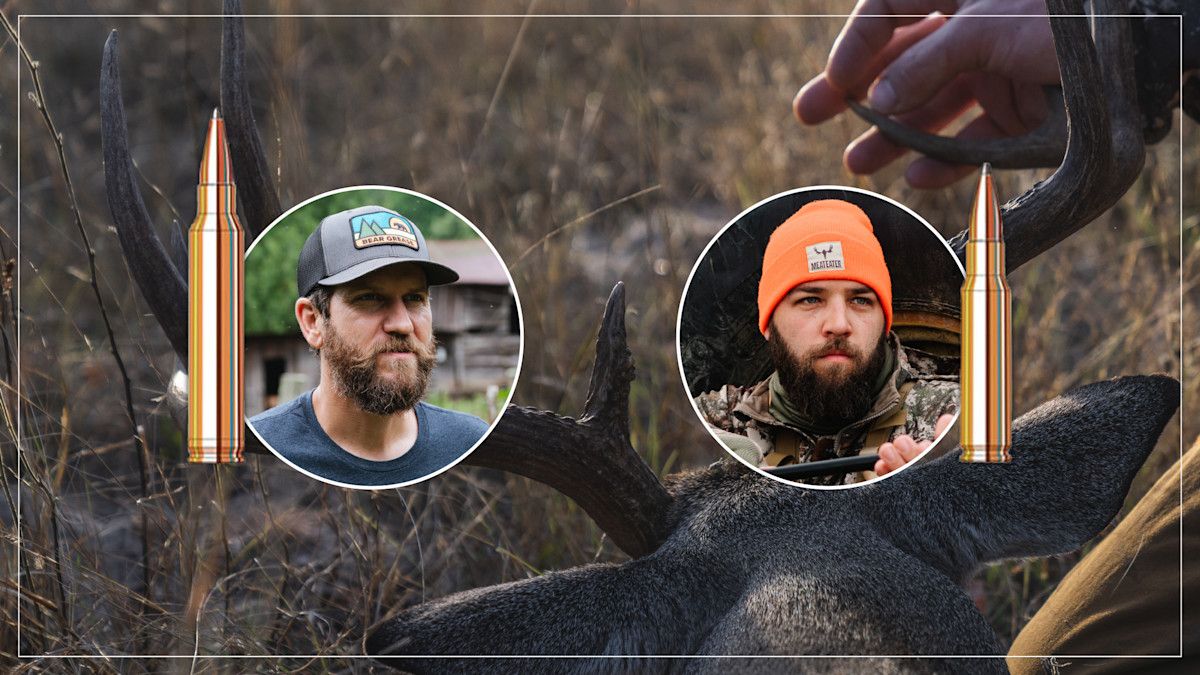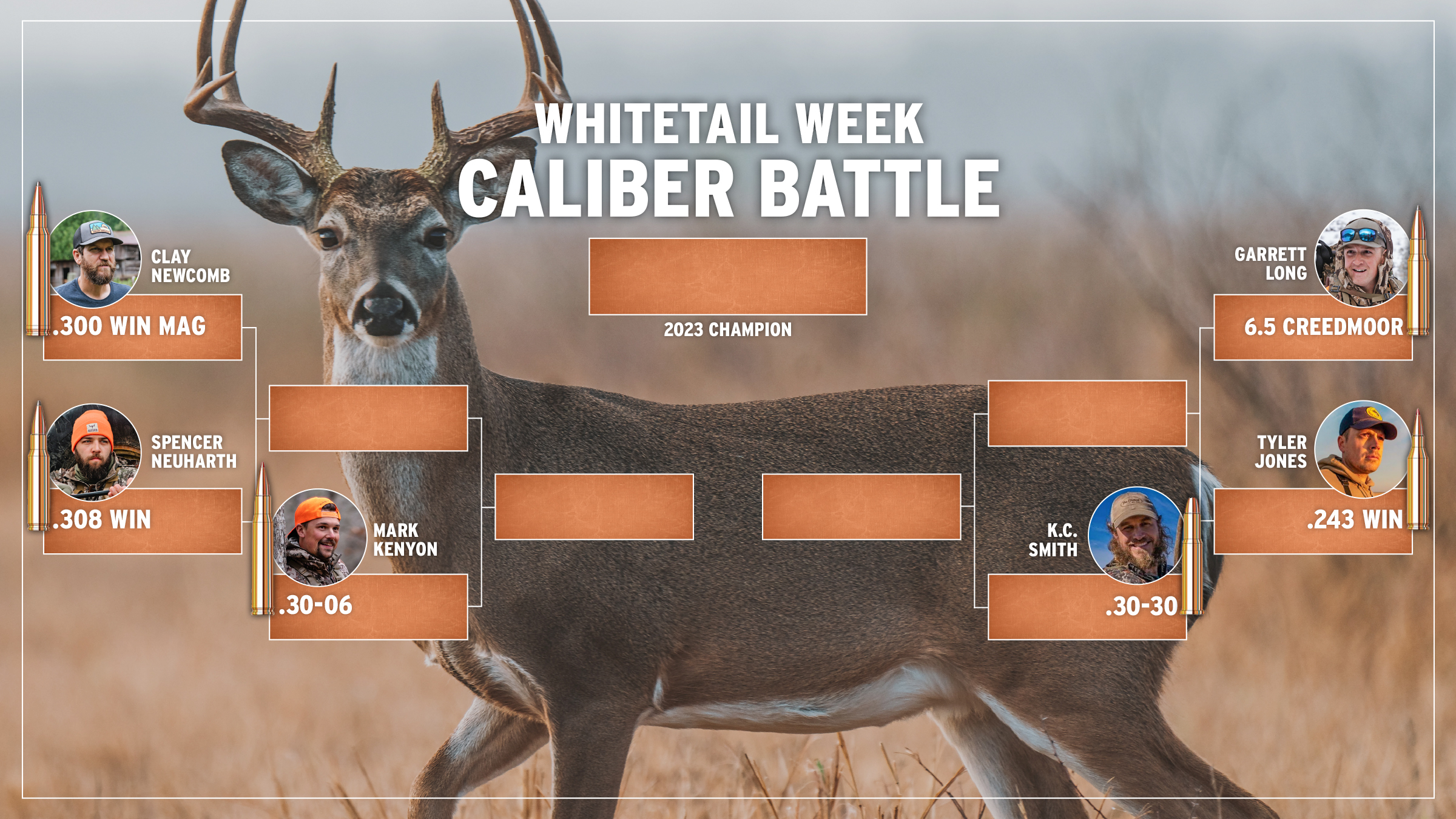
UPDATE: We have a winner! Spencer's .308 Win. pulled away from Clay's .300 Win. Mag. by a commanding 179-62 vote. Most voters who supported the .308 mentioned the .308's lesser recoil and more-than-adequate power for deer. Spencer's .308 is slated to go up against Mark's .30-06 in the next round, so be looking for that matchup to drop later today. Thanks to all who participated!
We covered this matchup in a Caliber Battle last year, but that contest wasn’t species-specific. If you want to select the better whitetail cartridge, there are a few other things to keep in mind.

Click here to vote on the other side of the bracket, Tyler's .243 Win. v. Garrett's 6.5 Creedmoor.
The Case for Clay’s .300 Win. Mag.
I’m on the record saying I’d never hunt deer with a .300 Win. Mag., but many of you disagreed. You’re in good company. Clay Newcomb didn’t hesitate when I asked him which cartridge he wanted for this tournament, and it’s easy to see why.
One word: power. The .300 Win. Mag. is the most powerful cartridge of any in this tournament. It slams through deer with a whopping 3,717 ft.-lbs. of energy at the muzzle, and with these 180-grain loads from Sig Sauer, maintains 1,637 ft.-lbs. of energy at 500 yards. For comparison, these 150-grain .308 Win. cartridges hit with only 951 ft. lbs. at that distance.
“It’s a big caliber for whitetail, no doubt,” Clay said. “But you can’t go wrong with too much gun. It’s an accurate cartridge, and I can shoot it for bear, moose, and whitetail. It’s an all-around North American big game rifle and keeps things simple.”
Some might argue that shot placement is more important than power. While it’s true that shot placement is king, power sure doesn’t hurt. As we covered here, hydrostatic shock is a very real phenomenon. The more power behind a bullet, the better the chance that your deer will drop in its tracks. Whitetail hunters often operate on relatively small properties, and no one likes blood-trailing a deer onto the neighbor’s land. Using the .300 Win. Mag gives you a better shot at avoiding the awkwardness of knocking on a door and asking to look for a dead animal on the back 40 next door.
The .300 Win. Mag. is also a better option if you think you might have to take a long-range shot. Its higher velocity means it drops less and is less affected by wind than the .308 Win., and it retains that energy and velocity at longer distances. If a bullet requires a minimum velocity of 1,800 feet-per-second to properly expand, for example, the .308 Win. mentioned above drops below that mark somewhere between 400 and 500 yards. The .300 Win. Mag. is still cruising along above 2,000 fps at 500 yards, which gives hunters an extra 100+ yards of range.
Whitetail hunting isn’t usually a long-range game, but those shots certainly aren’t out of the question. Clay didn’t take a long shot on this nice Nebraska buck, but it’s easy to imagine how he could have on those wide open plains.
The Case for Spencer’s .308 Win.
The .308 Win. isn’t as fast as the .300 Win. Mag., but it still has a lot to recommend it. In fact, one of its biggest selling points over the Win. Mag. is that it’s less powerful and produces less recoil. Felt recoil is dependent on rifle weight and powder charge, but all things being more-or-less equal, the .308 Win. hits with about 18 ft.-lbs. of recoil energy while the .300 Win. Mag. hits with about 26 ft.-lbs. And since 20 ft.-lbs. is generally considered the line at which hunters report discomfort, the .308 Win. holds a clear advantage in the “shootability” category.
Whitetail hunters might also argue that the .308 offers more than enough power and range for 99% of hunting scenarios. Your .308 bullet might not properly expand past 500 yards, but are you ever going to take a shot like that, anyway? There’s no nationwide data on average distance of shots on a whitetail, but this study from a South Carolina hunting club put the average at 132 yards. I think I’m on solid ground when I say that the vast majority of shots are within 200 yards, which is well within the capability of the .308 Win.
To put it another way, the .300 Win. Mag. offers more power for the very slim chance you’ll take a long-range shot on a whitetail. But you’re trading that advantage in 1% of cases for stiffer recoil on 100% of the shots you take. Lighter recoil reduces the odds of flinching, which allows you to take better shots in awkward shooting positions. It’s also less painful during a long afternoon at the practice range.
“My first deer rifle was a .308, and although I've gone up and down in cartridge size since then, there's a reason I keep coming back to that first gun year after year,” Spencer Neuharth told me. “It really is a sweet spot among the popular deer calibers. It's like having the bullet weight of a .30-06 with the recoil of a .270 and the ammo availability of a .223. It is a bit slower than some of its contemporaries, but I think modern scopes and their ability to quickly dial up a shot mask that flaw.”
Short-action .308 Win. rifles are generally lighter, but that’s not as much of a concern for whitetail hunters walking in 500 yards to a tree stand. But ammunition is cheaper (especially practice ammunition), and you can more easily find rifles in a variety of actions, including semi-auto and pump.
So, who you got? Comment below to cast your vote. If you want to explain your reasoning or you think I missed something, go for it. But you don’t have to. The cartridge that gets the most votes by 11:59 pm MT on Tuesday, October 3 will advance to the next round.



